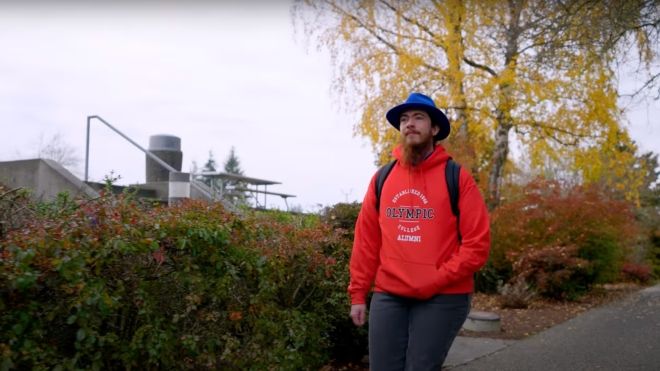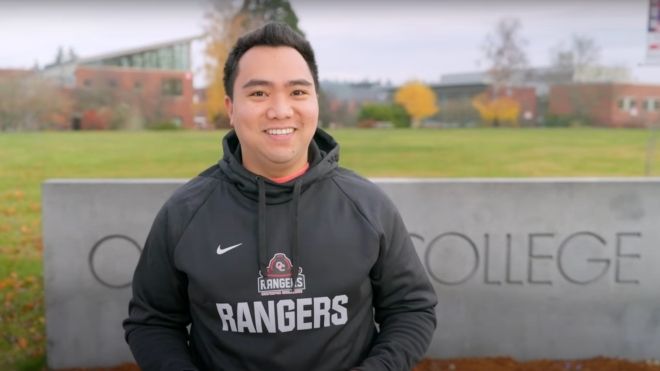OC Students Exchange Language, Culture, and Engineering Skills with Students in Brazil
On Oct 24, STEM students from Brazil’s UNOESC university stood in front of an audience of dozens inside Bremer Student Center to present a slideshow about a special exercise bike they had designed in collaboration with Olympic College students. Wesley Dalpiva led the presentation. He pointed to a video of a leg kicking back and forth, wires dangling from it on all sides. “That’s my leg, and I’m not the one moving it. Electric signals are,” he said.
The exercise bike uses these electric signals to stimulate muscle movement in the legs of paralyzed people. Over time, such movement can help these patients regain strength and the ability to move on their own.
The bike is the culmination of a yearlong collaboration between Brazilian university UNOESC, technical college UniSENAI, and OC, funded by a grant from 100,000 Strong in the Americas. With the grant funding, four students in OC's Math, Engineering, Science Achievement (MESA) program and a professor travelled to Brazil over the summer, and 17 students and faculty from Brazil visited OC in October. Students from each college also exchanged virtual lessons on language and culture.
The 100,000 Strong in the Americas Innovation Fund is a collaboration between the U.S. Department of State, U.S. Embassies, non-profit organizations, and companies. It supports partnerships between colleges in the U.S. and in other countries throughout the Western Hemisphere with student training and exchange opportunities.
While the students enjoyed the chance to travel internationally, their eyes lit up when talking about how their bike could help people. The design was inspired by the friend of one of the Brazilian professors an athlete who suffered a spinal cord injury that left him paralyzed. To access rehabilitative physical therapy, he had to travel away from his family.
The students designed the bike as a simple, low-cost tool that could be accessed by people who otherwise don’t have specialized healthcare close to home.
The bike uses myoelectricity–the electricity created by muscle movements. To design it, the students first gathered data of muscle movements in non-disabled people as they pedaled. That data and artificial intelligence were used to create a model of how the average person might ride the bike. They then stimulated paraplegic patients to move like that average model by sending myoelectric signals to their muscles through wires stuck to the skin of their legs.
Creating the bike required help from students in a variety of science, health, and engineering majors. Software engineers helped manipulate the data, mechanical engineers worked on the design, and physical therapists ensured the bike would work in a clinical setting.
The collaboration between the colleges was essential; when OC students were in Brazil, an important part of the bike had just been installed, but it wasn’t working because a magnet was interfering with signals from one of the wires. “I just loved troubleshooting that,” said Satiago Alvarez, an OC mechanical engineering student. He, along with 29 other students and professors, worked together to tweak the design until it worked. Dalpiva said that the collaboration and fresh perspective of students from OC helped them resolve the problem quickly.
Teachers from both colleges are still determining the project’s next steps. For example, they may extend the bike to include sensors for stimulating other parts of the body, like arms and hands. Already, the project has enhanced the lives of the students who worked on it.
Alvarez is planning to continue working on the bike, and he’s looking into grant funding to visit Brazil again next summer. Dalpiva is moving on to a different project, using AI to detect mouth cancers earlier. He said he'll take to this new project many lessons learned while working on the bike, such as the importance of keeping a thorough record of your work as an engineer.
“It’s been a really unique opportunity for our undergraduate students,” said Valério Junior Piana, the Head of Undergraduate Courses at UniSENAI Digital. “And we are so grateful for the kind reception we’ve had at OC.”


